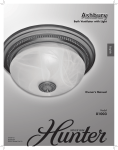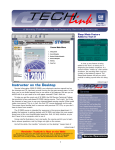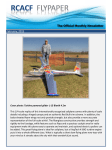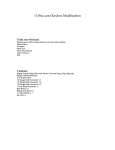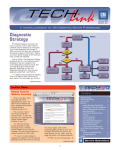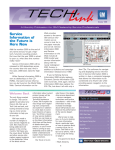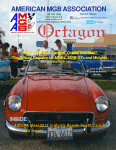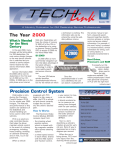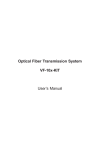Download Conventional Rack and Pinion Power Steering Operation
Transcript
December 2000 Volume 2, No. 12 used a stand-alone module. The EBCM controls current flow through the Magnasteer electromagnetic coil, both the amount (amperage) and the direction (polarity). Pulse width modulation is used to vary the voltage and the resulting current flow. Current varies between -2 and +3 amps. Current flows from the controller to the Magnasteer rotary actuator, mounted in the steering rack assembly. It consists of two magnets, a permanent magnet and an electromagnet. The electromagnet receives the variable current. The permanent magnet has 30 poles spaced at 12° intervals. There are two separate sets of pole continued on page 2 Magnasteer power steering is now available on a wide range of cars from all five GM divisions. Magnasteer is an electronic device added to conventional power rack and pinion steering to vary the amount of effort required to steer the car, dependent on vehicle speed. At low speeds, steering effort is lower, for ease in parking. As speed increases, steering effort is increased, for greater road feel. Additionally, on some models, evasive steering maneuvers also affect steering effort. Conventional Rack and Pinion Power Steering Operation An understanding of Magnasteer begins with an explanation of conventional power steering. In a conventional power rack and pinion steering gear, the steering input shaft is joined to the pinion by a torsion bar inside the valve body. Whenever the steering wheel is turned, the torsion bar twists slightly (a degree or two) as the steering effort is applied through the pinion to the resistance offered by the front wheels. The two halves of the spool-type hydraulic control valve are attached, one at each end of the torsion bar. So, when the torsion bar is twisted, the spool halves are realigned relative to each other and fluid is permitted to flow through to the steering gear. Steering effort, determined by the stiffness of the torsion bar and pump flow, is constant at all times. Magnasteer Operation In a car equipped with Magnasteer, the basic power rack and pinion steering system continues to function normally. Magnasteer does not affect flow, so normal boost is available at all times. The basic Magnasteer system varies only the driver’s steering effort, regulated according to vehicle speed. In current production, Magnasteer is controlled by the Electronic Brake Control Module (EBCM); a few models in past years 1 Contents Magnasteer ® Power Steering . . . . . . . . . . . . . .1 Power Steering Analyzer . . . . . . . . . . . . . . . . . .3 Identifying OE Engine Oil Filters . . . . . . . . . . . . .3 Water Inside Rear Spoiler . . . . . . . . . . . . . . . . .3 RKE Receiver Module Location . . . . . . . . . . . . . .3 Engine Performance Diagnosis . . . . . . . . . . . . . .4 Thermistors . . . . . . . . . . . . . . . . . . . . . . . . . .4 Cruise Control Cancels Intermittently . . . . . . . . .5 Xtreme Pickup Decal Installation . . . . . . . . . . . . .5 GM Service Clubs, Part 2 . . . . . . . . . . . . . . . . .6 Service Operations Advisory Group . . . . . . . . . . .6 TAC Tips . . . . . . . . . . . . . . . . . . . . . . . . . . . . .7 Tacker Sensitivity to Vibrations . . . . . . . . . . . . . .7 Service Bulletin Based on Reader Information . . . .7 Bulletins . . . . . . . . . . . . . . . . . . . . . . . . . . . . .8 Thanks for Information . . . . . . . . . . . . . . . . . . .8 Tire Pressure Monitor Tool . . . . . . . . . . . . . . . .8 Service Operations continued from page 1 pieces, inner and outer, which close the magnetic field. The permanent magnet sits between the inner and outer poles of the electromagnet. The strength and polarity of the magnetic field in the electromagnet determines the effect Magnasteer has on steering input. At zero mph, negative current flows thorough the electromagnet, and the magnets begin to repel each other. The more the magnets repel each other, steering effort decreases, as though the torsion bar became lighter. This is the desired condition at low road speeds, such as parking. At about 45 mph, there is no current flow through the magnetic coil, so steering effort is determined only by the torsion bar and pump flow. Above 45 mph, current flows in a positive direction and increases as speed increases. The electromagnetic pole pieces and the permanent magnet attract each other, which raises the torsional rate of the steering gear, and adds to steering effort. It’s as though the torsion bar gradually became stiffer. This provides greater road feel. Service Diagnosis may be required, based on one of three driver concerns. 1. Light steering effort at all speeds 2. Heavy steering effort at all speeds 3. Erratic steering effort levels at various speeds Systematic diagnostic procedures are presented in the appropriate service manual. NOTE: The Magnasteer system on some vehicle lines can be recalibrated for steering effort, using the Tech 2. There are three settings: Factory, More Firm, and Less Firm. On those vehicles where recalibration is available, use this feature only at the customer’s request. Refer to the appropriate service manual for details. The Magnasteer activator is serviceable only by replacing the entire steering rack assembly. Individual components are not available. Electronic Testing Malfunctions in the electronic portions of the Magnasteer system are diagnosed using the Tech 2 to access diagnostic codes. Only a highly informed driver could tell the difference between systems. Regardless of which version of Magnasteer is installed on a vehicle, the effect on the driver is the same -- steering effort is noticeably easier at low speeds and increases as the car goes faster. Publisher & Editor: Mark Stesney GM Service Operations [email protected] Technical Editor: Jim Horner [email protected] 1-248-816-3641 Production Manager: Marie Meredith Desktop Publishing: FAX number: 1-248-649-5465 Write to: TechLink PO Box 500 Troy, MI 48007-0500 Magnasteer MAGe In this version, the Magnasteer effect depends entirely on road speed, and there is no change during evasive maneuvers. VSSM Communications Gracemary Allen Greg Szpaichler, MediaWurks [email protected] MAGe An added feature on some Magnasteer systems comes into play in a skidding condition. If excessive lateral G-forces are detected, Magnasteer increases steering effort, to encourage the driver not to oversteer. The latest version of Magnasteer eliminates the permanent magnet. In this form, one pole piece of the electromagnet is mounted to the input shaft and the other to the pinion shaft. At the lowest speeds, there is no current flow through the electromagnet, and steering effort is dependent only on the stiffness of the torsion bar. As speed increases, current flow through the electromagnet increases, and steering effort increases. GM TechLink is a monthly magazine for all GM retail technicians and service consultants providing timely information to help increase knowledge about GM products and improve the performance of the service department. This magazine is a companion to the GM Edge publication. Hydraulic Testing Tips The power steering system section of the service manual presents a test procedure for the Magnasteer hydraulic components, which are the same as those used in non-Magnasteer systems. Use of tester J-44721 permits you to test the operation of the steering gear and the pump, and identify system restrictions. – Ken Hill and Scott Bower contributed to this article. General Motors service tips ar e intended for use by professional technicians, not a "do-it-yourselfer." They are written to inform those technicians of conditions that may occur on some vehicles, or to provide information that could assist in the proper service of a vehicle. Properly trained technicians have the equipment, tools, safety instructions and know-how to do a job properly and safely. If a condition is described, do not assume that the bulletin applies to your vehicle or that your vehicle will have that condition. See a General Motors dealer servicing your brand of General Motors vehicle for information on whether your vehicle may benefit from the information. Inclusion in this publication is not necessarily an endorsement of the individual or the company. Copyright© 2000 General Motors Corporation All rights reserved. 2 Return to page 1 Tools Power Steering Analyzer Power Steering Analyzer J-44721, a new essential tool, has been released by Kent-Moore and will be in your dealership soon. You’ll need it to perform the power steering system diagnostic procedures in the 2001 service manual. In addition to the pressure gauges, the analyzer contains a flow meter to measure fluid flow under various conditions. And, a valve permits adding a variable restriction to the circuit as called for in the service manual procedures. The power steering system must be warmed up by allowing the engine to idle until it reaches operating temperature. If you already have the J-25323, you can convert it to become the J-44721 by adding the components in kit J-25323-UPD. Identifying OE Engine Oil Filters If you question whether the proper routine maintenance has been performed on a vehicle, there are several things to look at. One way to check if routine maintenance has been performed is to identify the current engine oil filter. If the vehicle still has the original equipment (OE) oil filter after 20,000 miles, for example, routine maintenance may not have been performed. For 1998-2001 models equipped with a GM Powertrain produced engine, there are several ways you can distinguish between OE oil filters (factory The analyzer is installed in the pressure line between the pump and the steering gear. If the system has been repaired, accurate diagnosis requires that the system be bled of air before beginning the test. Also, any air introduced during the installation of the analyzer must be purged. Maintain the proper level of fluid in the reservoir during the test; use only approved power steering fluid. The J-44721 analyzer is an updated version of the J-25323 analyzer, which was previously essential for Oldsmobile dealers and available to all dealers. The major difference between the two analyzers is that the J-44721 is equipped with two pressure gauges instead of one, for accurate readings at both low and high pressures. Also, the J-44721 includes an adapter assortment that permits using the analyzer on all current GM cars and trucks. J-44721 permits you to test the operation of the steering gear and the pump, and identify system restrictions that may be present in the pressure or return lines. Testing Tips The power steering system section of the service manual provides a test procedure for the power steering system hydraulic components. Use of analyzer installed) and non-OE oil filters (which have been installed after the vehicle was new). This information applies to all vehicles except Saturns, Chevrolet Metro, Tracker and Prizm, Cadillac Catera, and 3.5L V6 (LX5) engines with the PV6 cartridge type filter. 1. OE filters have a small part number label (25.4mm x 35mm). Non-OE filters have a larger label (39mm x 60mm) that includes tightening instructions. 2. OE filters have a seal with a red teflon coating. Non-OE filters have a black, uncoated seal. 3. All filters have an ink-stamped 6 digit Julian date code at the wrench flat end of the filter (065003 = March 5, 2000, 3rd shift). OE filters have an "OE" at the end of the date code. Non-OE filters do not. For Chevrolet Metro and Tracker models, the original filters have Suzuki printed on them, and replacement filters do not. On Chevrolet Prizm models, the original filters are black with white Japanese characters, and a caution in English. Replacement filters do not have any Japanese writing. The next time routine maintenance comes into question, identifying the engine oil filter may help you determine if scheduled maintenance has been performed. – Rich Burrell The hydraulic tests require you to observe pressure and flow readings under various operating conditions and engine speeds. Never close the control valve on the analyzer unless told to do so by the procedure, and never leave the valve completely shut for more than 5 seconds at a time. – Matt Stange contributed to this article Water Inside Rear Spoiler A water sloshing sound may be heard coming from the rear spoiler of some 2000 Pontiac Grand Prix models when the trunk lid is raised and lowered. If it is confirmed that water is inside the spoiler, remove the spoiler and look for a small hole on both the left and right underside of the spoiler approximately 16 inches inboard from the outboard tip of the spoiler, and two a couple of inches from the rear edge. The small holes may be covered by pieces of tape that should be painted the same color as the spoiler. Remove the tape to drain the water from the spoiler. Do not retape over the holes. Once the water is removed from the spoiler, reinstall the spoiler on the vehicle. RKE Receiver Module Location The Remote Keyless Entry (RKE) module/receiver has been relocated on 2001 Pontiac Grand Prix models. The module is now located at the cross car beam in front (windshield side) of the passenger side air bag. It was previously located behind the Driver Information Center. At its new location, the RKE module is accessed by removing the defroster grill. To remove the module, it must be disengaged from the retaining tabs by moving it to the left and then pulling up. – Fred Tebbets 3 Return to page 1 Engine Controls between frequency and duty cycle; analog and digital; PERFORMANCE DIAGNOSIS 2. knowledge of electrical basics Think of the best engine performance technician you’ve ever worked with -- how is this person different from you? Likely, you both have many of the same things available. 3. knowledge of indi vidual components - essential tools such as the Tech 2 and Fluke 87 DVOM, absolute necessities for this type of work. - the same diagnostic resources, such as SI2000 for bulletins, preliminary information and service information. - access to Technical Assistance for those tough cases. Probably the only thing differentiating you from this person is among these four things, listed in order of importance: 1. diagnostic strategy Class 2 and UART; capacitance and inductance 4. extra tools Here they are in detail. Get the picture? Diagnostic Strategy Individual Component Knowledge Strategy Based Diagnostics (SBD), along with a complete understanding of the service resources available, are critical in the success of any technician. These skills are the most important to learn, above all else. Service manual diagnostics for individual components are the front line of defense. You should always refer to the diagnostic charts associated with various fault codes or symptoms. Electrical Basics But, you’ve truly mastered a component only when you begin to understand the importance of the voltage level or frequency you’re about to measure, or the scan data you’re about to read, and the potential causes for variations as you read each step. Among the essentials you need to know: - the relationships between volts, amps and ohms - schematic reading skills - the differences THERMISTORS Engine Coolant Temperature Sensor (ECT) -- affects fuel delivery, idle, TCC apply, EGR, cooling fans, EVAP, knock/ignition control Intake Air Temperature Sensor (IAT) -- affects air density air/fuel adjustments, spark adjustments Transmission Fluid Temperature Sensor (TFT) -- affects TCC apply, line pressure Extra Tools Extra tools are something you can buy any time, once you understand their benefits. Buying a tool before realizing its potential is a bad idea. Also realize that mastering diagnostic strategy, electrical basics and component knowledge should come before you even consider buying advanced tools. The accompanying article is the first of Temperature vs. Resistance Values (approximate) (first in a series) A thermistor is a temperature-sensitive resistor. The thermistors used in GM vehicles have a negative temperature coefficient, meaning the resistance goes down as the temperature goes up. Here are some thermistors used by the Powertrain Control Module (PCM), along with their role in PCM decision making. There are principles behind the names of various engine sensors and output devices. You’re on the road to higher understanding once you realize that a component is not just an Intake Air Temperature Sensor but a thermistor, or not just an Exhaust Gas Recirculation Valve but a solenoid. This type of knowledge comes from training or experience. °C °F Ohms 100 212 177 90 194 241 80 176 332 70 158 467 60 140 667 50 122 973 40 104 1459 30 86 2238 20 68 3520 10 50 5670 0 32 9420 -10 14 16180 -20 -4 28680 -30 -22 52700 -40 -40 100700 several to be devoted to engine controls. With every coming article, we intend to feature a specific powertrain input or output device. We’ll answer many questions, including: - What type of device is it? - What is its purpose? - How is built? - What does its circuitry look like? - How is this component best diagnosed? (scan tool, DVOM) The purpose of these articles is to help you develop the skills and knowledge you need, to become the performance technician that others consider the best. Concentrate on whichever of these four things you need to work on, to differentiate yourself from the others. Only you know what they are. Engine Oil Temperature Sensor (EOT) -- affects engine oil life monitor calculations Note the change in resistance for temperature is not linear. For example, the difference in resistance between –40 and –22 degrees F, a change of 18 degrees, is 48,000 ohms. The change between 194 and 212 degrees, also 18 degrees, is only 64 ohms. All thermistor-based sensors have two wires. Circuit basics can be explained using the IAT diagram. The PCM supplies a 5volt signal through a dropping resistor and out to the IAT on the tan wire. The IAT provides a ground path through the sensor and back to the PCM on the black wire. Note that this sensor ground is often shared by other components and can be influenced by a shorted condition within them. 4 Return to page 1 tions to just one resistor. This strategy is to maximize the accuracy of the sensor for higher engine temperatures and was necessitated by the resistance characteristics of the sensor. This results in an obvious shift in voltage at the 122 degree mark. At that point, the voltage jumps up immediately from below 1 volt to about 3.5 volts. This becomes important to know if you use a scope to diagnose an ECT circuit live or when using a scan tool on a truck product that includes ECT voltage on the data list. When the IAT sensor is very cold (high resistance) it acts like a roadblock for the flow of electrons to ground. The IAT sensor signal in the PCM is high. As the IAT sensor heats up, the resistance drops, and more voltage is dropped across the sensor. The circuit is very simple. Circuitry on a thermistor-based sensor is very easy to test. On a cold engine (one that has not run within six Don’t forget the potentially shared ground paths with other sensors. Thermistors rarely fail for reasons other than circuitry. Terminal corrosion at ECT sensors is a common cause for failure. Connector and sensor replacement is typically necessary. Sensor wiring for an ECT sensor is unique. Earlier, we mentioned the difference in resistance changes on the upper and lower end of the tempera- It’s unlikely that you’re going to get a P0118 ECT sensor code to work on tomorrow to exercise your new knowledge. But, the sooner you practice, the more likely that you will retain it. So get out there and give those Tech 2 circuit checks a try. Be on the lookout in future issues for more articles on Performance Diagnosis. - Craig Blake Cruise Control Cancels Intermittently hours), scan data for ECT and IAT should be within ten degrees Fahrenheit. If a malfunction in the circuit is suspected, observe the scan tool parameter with the sensor unplugged. The unplugged sensor will create very high (infinite) resistance and the scan tool should show a very cold temperature (approximately -40 degrees Fahrenheit). If this does not occur, check the sensor wire for open circuit voltage with a Fluke 87. It should be 5 volts. Less than 5 volts indicates a short to ground condition or a bad PCM. ture scale. In the PCM, there are two paths for the 5-volt reference. When the engine temperature is below 122 degrees Fahrenheit, it travels through two dropping resistors. When it reaches 122 degrees Fahrenheit, it transi- The cruise control may cancel intermittently when using the left turn signal on some 2000 Buick Century and Regal models. The resume function is still operational after the cruise control cancels. This condition may be caused by an internal switch in the multifunction lever causing a backfeed to the cruise control module. The module thinks it has seen a brake switch input signal and cancels the cruise control set speed. If this condition is verified, replace the multifunction lever. Parts are available through GM SPO. – Wayne Zigler Xtreme Pickup Truck Decal Installation Xtreme models are shipped with an Xtreme decal that fits the windshield. This decal should not be installed during pre-delivery, because it may not be legal to do so in some states. Leave the decal in the vehicle; installation is at the customer’s discretion. - Dan Oden The next quick circuit check involves a test lead outfitted with two appropriate male terminals. Use this test lead to jump the two sensor wires at the unplugged connector and observe the scan tool parameter. This low resistance connection should yield a very high temperature (260 degrees Fahrenheit or above). Failure of this test indicates ground circuit problems. 5 Return to page 1 GM Service Clubs, Part 2 In the November issue of GM TechLink, we listed a number of GM service clubs around the country that meet to talk about the service issues that dealership service departments face each day. This interactive communication is one of the benefits for service managers who attend a local service club meeting. The clubs provide a way for service managers to access a wide array of information from other dealership service departments as well as a number of GM sources. Following is a list of additional GM service clubs. GM supports local service clubs and many GM representatives attend the club meetings. For more information about GM service clubs, contact any of the clubs listed here. Service Operations Advisory Group GM Service Operations relies on input from a number of sources to assess the opinions and needs of retail dealership service departments across the country. One of these sources is a group of eight technicians, recommended by their TechLine representatives in the five regions. This advisory group serves as a sounding board for service issues, and their feedback is forwarded to the appropriated department within GM for evaluation. Their suggestions may also lead to future articles in GM TechLink. Service Operations would like to extend their thanks to the present members of the advisory group, listed here. SOUTHEAST REGION Atlanta Service Club Contact: Jeff Burns Jerry Brown Chevrolet, Buford, GA 770.945.4981 Metrolina GM Service Managers Club Contact: Tommy Cross Dale Earnhardt Chevrolet, Newton, NC 704.465.3251 Piedmont Service Managers Club Contact: Jeff Keith Modern Chevrolet, Winston Salem, NC 336.722.4191 Inland Valley Service Managers Club Contact: John Arnold Beach City Chevrolet, Long Beach, CA 562.597.6633 WESTERN REGION Central Coast Service Managers Club Contact: Steve Montana Rio Vista Chevrolet, Buellton, CA 805.688.3231 LOCAR Club Contact: Gary Loy Cormier Chevrolet, Long Beach, CA 310.830.5100 Las Vegas Service Managers Club Contact: Tom Hudlick Cadillac West, Las Vegas, NV 702.873.8888 Blue Ridge Service and Parts Managers Club Contact: Sam Lilly Royal ChevroletOldsmobile-Cadillac, Lynchburg, VA 804.237.9400 San Diego Service Managers Club Contact: Earl Ashbury Weseloh Chevrolet, Carlsbad, CA 760.438.1001 Triangle Service Managers Club Contact: Tony Crabtree Don Lacefield ChevroletBuick, Hillsborough, NC 919.732.2151 Dennis Murphy Master Technician Superior Oldsmobile, Cadillac, GMC Paul Richards and Richard Mcintyre, owners Brighton, MI George Reed Shop Foreman/Asst. Service Manager Fischer Chevrolet/Oldsmobile Bob Fischer, president Titusville, FL Max Millender ASE Master Technician Ewing Buick GMC Pontiac Fin Ewing, dealer principal Plano, TX Jon Finefrock Master Technician Faulkner Chevy, Inc. Judith Faulkner, owner Lancaster, PA Seattle Service Club Contact: Roger Sideck Bill Hazelett Chevrolet, Kent, WA 800.638.7222 Inland Empire Fixed Operations Club Contact: Dale Poole Chipman & Taylor Motors, Spokane, WA 509.334.3555 Salt Lake Service Club Contact: Ty Johnson Jerry Seiner Buick-PontiacGMC, Inc., North Salt Lake, UT 802.298.5163 Lance Mossman CMAT, L1 Applegate Chevrolet Jim Applegate, owner Flint, MI Dennis Burtness Shop Foreman Burtness Chevrolet John Bowditch, owner Orfordville, WI Mark Haynes ASE Master Technician Steve Coury Buick-Pontiac-GMC Steve Coury, owner Cottonwood, AZ Joesph Herring ASE Master Technician Harold Chevrolet Jim Lupient, owner Boomington,MN 6 Return to page 1 TAC Tips 2001 Pontiac Aztek Requires Windshield Removal To Replace Evaporator Core ing the evaporator core, some of the bolts retaining the cross vehicle beam to the hinge pillars cannot be removed due to contact with the windshield. The bolts are approximately 810 inches in length. About 3-4 inches will Some information was omitted from SI2000. When remov- Tracker Sensitivity to Tire Vibrations The 1999 Tracker became more sensitive to wheel and tire imbalance and tire radial force varia tion, due in part to the design change to rack and pin ion steering. OEM tire specifications and the tire and wheel matching and balancing operations at assembly were made more stringent. In 2000, Tracker design changed to a hub centered wheel which eliminated the vibrations caused by off-center mounting of the wheel. The Tracker, however continues to be sensi tive to tire induced vibra tions, and customers may benefit from following the TPC Specification recommendation. Steering Wheel Shake/Vibration After Tire Rotation After tires are rotated, steering wheel vibration concerns may suddenly reappear. The 1999 Tracker uses a lug centered wheel, and relies upon the lug nut taper-to-wheel hole taper interface to center the wheel and tire assembly on the hub. Steering wheel vibrations induced by off-center wheel installations may be significantly reduced with the following procedure. Start by ensuring that tire air pressure is correct. Balance the wheel and tire assembly using electronic balancing equipment which also measures radial force variation. Wheel and tire assemblies which have a radial force varia tion reading of greater than 9 pounds should be evaluated for cause, and may require replacement of the wheel or tire. Follow this procedure to install wheel lug nuts to aid in centering the wheel on the hub: Rotate the hub to posi tion two studs of the five at the top of the circle and remain in the hole when they contact the windshield. The windshield will need to be removed to complete the repair. Take care to avoid breaking the windshield during removal. – GM Technical Assistance Tire Size Place the wheel on all five studs, and spin on the top two lug nuts finger tight. Service Operations, working with Engineering, investigated the condition and found that Zaffino’s suggestion worked. Rotate the wheel 180° so the opposing one stud is at the top of the circle, and spin the lug nut on finger tight. The result is service bulletin 00-01-39001. The bulletin points out that a washer, P/N 5462496, should be installed between the right-hand air outlet duct housing and the control lever at the pivot point in order to increase the tension to hold the air outlet shut-off door open. This will keep the shut-off door in the open position when the blower fan is on high while still allowing the thumbwheel to rotate easily. Using hand tools, tighten these three points of the lug nut pattern to just past finger tight, which will center the wheel on the hub. Install the remaining two lug nuts and, using a star pattern, evenly torque all lug nuts to the correct value. Steering Wheel Shake/Vibration After Tire Replacement The OEM tire has a Tire Performance Criteria Specification (TPC Spec) number on the sidewall. Replacement tires should carry the same TPC Spec number. If not, different or unwanted ride characteristics, such as steering wheel shake or vibration may be induced. – Don Sherman con tributed to this article. B 26 PSI 180 kPa 1043MS 4WD base Uniroyal P205/75R15 Tiger Paw 26 PSI 180 kPa 1031MS Zaffino says that when he diagnosed the condition, he knew that the tension needed to be increased somehow on the air outlet door. “It needed just a little extra tension, but there’s not much space in there. I first tried to place foam in the vent, but it would tear, and it needed to be thicker. Then I tried fabricating a shim that was cut to size. It provided the tension needed and was held in place by the vent. “I’m proud that the information was used by GM. I’m glad I could help.” Now, will all reader suggestions become bulletins? Probably not. But if you have a suggestion for a product condition, try submitting a VME product report. This system allows you to leave a voice mail message regarding any current product condition you’ve come across that you think GM engineers should know more about. To submit a product report, call 1-888-274-4185. When you are asked to input the mailbox number, use the following: - Mailbox 32000, Truck Temperature Goodyear P195/75R15 Wrangler ST The DeVille’s right-hand HVAC air outlet vent would close while the blower is on high, and Gary Zaffino, a 21-year veteran technician at Massey Cadillac in Orlando, FL had come up with the fix. parallel to the road sur face. Pressure TPC Spec Treadwear Traction 2WD base GM is listening. Case in point: a suggested repair for 2000 Cadillac DeVille models was sent in to us here at GM TechLink. Zaffino suggested fabricating a shim that could be installed on the left and right side of the vent. This would increase the tension on the blower door and prevent it from closing while the blower was set on high. OE information for the 1999 Tracker: Model Brand Service Bulletin Based on TechLink Reader’s Information 340 480 B B B - Mailbox 32001, Car and U-Van - Mailbox 32002, Powertrain GM values input from the field on product concerns. Your insight can help GM increase vehicle quality and owner satisfaction. 7 Return to page 1 Bulletins – November 2000 This review of service bulletins released through mid-November lists the bulletin number, superseded bulletin number (if applicable), subject and models. GENERAL INFORMATION: 00-0089-024; September, 2000 Bulletin Summary; 2001 and Prior Passenger Cars and Trucks Warranty; 1996-2001 Passenger Cars and Light Duty Trucks BRAKES: 99-05-25-003A; Cancellation of DBC 7 Diagnostic Assistance and Parts Retur n Program; 1999 Buick Century, Regal; 2000 Chevrolet Cavalier, Impala, Malibu, Monte Carlo, Venture; 2000 Oldsmobile Silhouette; 2000 Pontiac Sunfire, Montana HVAC: ENGINE/PROPULSION SYSTEM: 00-01-38-008; A/C Inoperative (Repair Wires and Reroute Harness); 2000 Chevrolet and GMC S Truck Models With 2.2L Engine (VIN 4 -- RPO LN2), Shreveport Assembly, Prior to VIN Breakpoint Y8302995 99-06-01-002E; Exchange Program for 2001 Model Year; 2001 Chevrolet and GMC C/K and G Light Duty Models, Chevrolet and GMC B7, C6, C7 Medium Duty Models with 8.1L Engine (VINs E, G -- RPO L18) 00-01-38-009; Refrigerant Dye Added to A/C System at Assembly Plant; All 2001 Passenger Cars 00-06-01-022; Engine Noise (Replace Belt Tensioner); 1999-2001 Chevrolet Tracker with 2.0L Engine (VIN C -- RPO L34) SUSPENSION: 00-06-03-008; Battery Testing Using Essential Tool J42000 Battery Tester; 2001 Corvette 99-03-11-001A; Cancellation of Diagnostic Assistance and Parts Restriction Program for Delphi Chassis Suspension Components; 1999 Chevrolet and GMC C1/K1 Models (Silverado and Sierra) with MSR (Manual Selectable Ride) RPO ZX3 00-03-08-003; Revised Lower Control Arm Removal/Installation Procedure and Fastener Tightening Specifications; 19972000 Chevrolet Malibu, Oldsmobile Cutlass and Alero, Pontiac Grand Am 00-03-10-003A; General Motors Tire 00-06-04-042; Malfunction Indicator Lamp (MIL) On With DTC P0446 Set (Reprogram PCM); 1998-2000 Chevrolet and GMC K/K Models with 7.4 L Engine (V(N J -- RPO L29) with California Emissions (NB6) 00-06-04-044; Engine Hesitates, Stalls and/or Will Not Start (Replace Modular Fuel Sender Strainer); 2000 Chevrolet Cavalier, Malibu; 2000 Oldsmobile Alero; 2000 Pontiac Grand Am, Sunfir e Thanks for the Information TRANSMISSION/TRANSAXLE: 00-07-30-017; Allison Automatic Series 1000 Transmission Exchange Program (Early Concern Detection); 2001 Chevrolet and GMC C/K 2500/3500 Pickup Models with Allison Automatic Series 1000 Transmission (RPO M74) BODY AND ACCESSORIES: 00-08-42-007; Stop/Tail Lamp(s) Inoperative or Intermittent and/or Water in Lamp (Replace Circuit Board/Gasket and/or Lamp Assembly); 1997-1999 Chevrolet Malibu, 1999-2000 Pontiac Grand Am 00-08-49-011; Availability of Smoker’s Package; 2001 Chevrolet Venture, 2001 Oldsmobile Silhouette, and 2001 Pontiac Montana 00-08-50-014; Driver’s Bucket Seatback Movement During Braking (Replace Seatback Recliner Assembly); 2000 Chevrolet and GMC C/K Pickup (Silverado and Sierra) and Utility (Suburban, Tahoe, Yukon, Yukon XL) Models 00-08-52-004A; Intermittent Operation of Remote Keyless Entry System (Replace Instrument Panel Cluster); 2000 Chevrolet Impala, Monte Carlo 00-08-61-003; Clunk/Pop Noise From Front Of Vehicle (Shim Rear Frame/Cradle Mounts); 2000 Chevrolet Impala, Monte Carlo 00-08-110-004; Rear Quarter Trim Gaps to the B-Pillar (Insert Screw); 19982000 Chevrolet Camaro (coupe); 19982000 Pontiac Firebird (coupe) GM Service Operations sent out a questionnaire asking about the Tech 2 and Electrical Service Information in late September to every dealership in the U.S. The questionnaire was also distributed throughout GM dealerships around the world. The efforts of everyone who completed a questionnaire are appreciated. All of the data is being compiled and a summary of the results of both questionnaires will be put together. With this feedback from actual users of the tools, future product improvements will be made based on what technicians want and need. The goal was to gather feedback about the operation and use of the Tech 2 as well as GM Service Information. The response has been overwhelming and GM Service Operations would like to say “Thanks.” Thanks to all who responded to the questionnaires and look for more details soon about future enhancements based upon your feedback. – Jeff Flood ERRATA 2001 Tire Pressure Monitor Tool An illustration in the November, 2000 issue of GM TechLink was incorrect. The tool number J-41760 is correct, but this is what the Tire Pressure Sensor Programmer tool looks like. 8 Return to page 1








